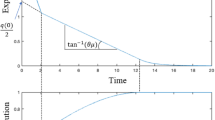Abstract
We study the marginal impact of customer flexibility in service systems. We consider a queueing system with multiple parallel servers, in which a proportion of customers are flexible and can go to any server, while the remainder require service at a particular server. We show that the stationary expected waiting time is decreasing and convex in the proportion of flexible customers. We also show, for a related Inventory Model, in which servers are never idle and can build up inventory, that convexity holds in a strong sample-path sense. Our results reinforce the idea that a little flexibility goes a long way.
Similar content being viewed by others
References
Akgun, O.T., Righter, R., Wolff, R.: Multiple server system with flexible arrivals. Adv. Appl. Probab. (to appear)
Bambos, N., Michailidis, G.: On parallel queueing with random server connectivity and routing constraints. Probab. Eng. Inf. Sci. 16, 185–204 (2002)
Daley, D.J., Rolski, T.: Finiteness of waiting-time moments in general stationary single server queues. Ann. Appl. Probab. 2, 987–1008 (1992)
Ephremides, A., Varaiya, P., Walrand, J.: A simple dynamic routing problem. IEEE Trans. Autom. Control AC-25, 690–693 (1980)
Foley, R.D., McDonald, D.R.: Join the shortest queue: stability and exact asymptotics. Ann. Appl. Probab. 11, 569–607 (2001)
Foschini, G.J., Salz, J.: A basic dynamic routing problem and diffusion. IEEE Trans. Commun. COM-26, 320–327 (1978)
He, Y.T., Down, D.: On accommodating customer flexibility in service systems. Inf. Syst. Oper. Res. 47, 289–295 (2009)
Hordijk, A., Koole, G.: On the optimality of the generalised shortest queue policy. Probab. Eng. Inf. Sci. 4, 477–487 (1990)
Koole, G., Sparaggis, P.D., Towsley, D.: Minimising response times and queue lengths in systems of parallel queues. J. Appl. Probab. 36, 1185–1193 (1999)
Menich, R., Serfozo, R.F.: Optimality of routing and servicing in dependent parallel processing stations. Queueing Syst. 9, 403–418 (1991)
Mitzenmacher, M.: The power of two choices in randomized load balancing. IEEE Trans. Parallel Distrib. Syst. 12, 1094–1104 (2001)
Shaked, M., Shanthikumar, G.: Stochastic Orders and Their Applications. Academic Press, San Diego (1994)
Turner, S.R.E.: The effect of increasing routing choice on resource pooling. Probab. Eng. Inf. Sci. 12, 109–124 (1998)
Weber, R.R.: On the optimal assignment of customers to parallel servers. J. Appl. Probab. 15, 406–413 (1978)
Winston, W.: Optimality of the shortest line discipline. J. Appl. Probab. 14, 181–189 (1977)
Author information
Authors and Affiliations
Corresponding author
Rights and permissions
About this article
Cite this article
Akgun, O.T., Righter, R. & Wolff, R. Understanding the marginal impact of customer flexibility. Queueing Syst 71, 5–23 (2012). https://doi.org/10.1007/s11134-011-9271-9
Received:
Published:
Issue Date:
DOI: https://doi.org/10.1007/s11134-011-9271-9




